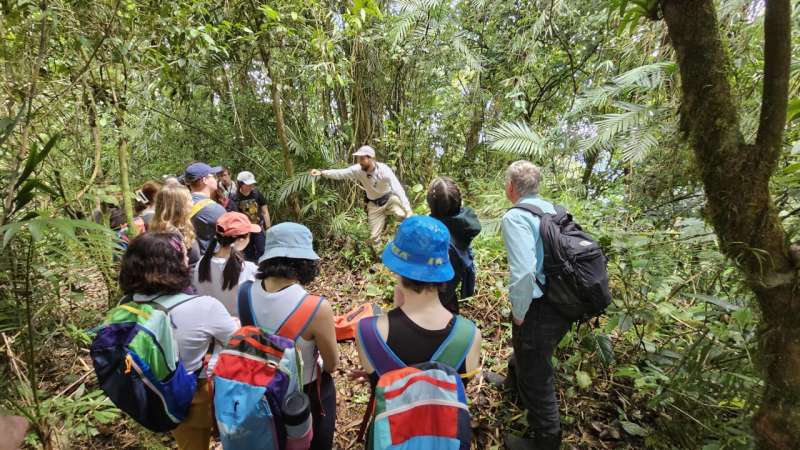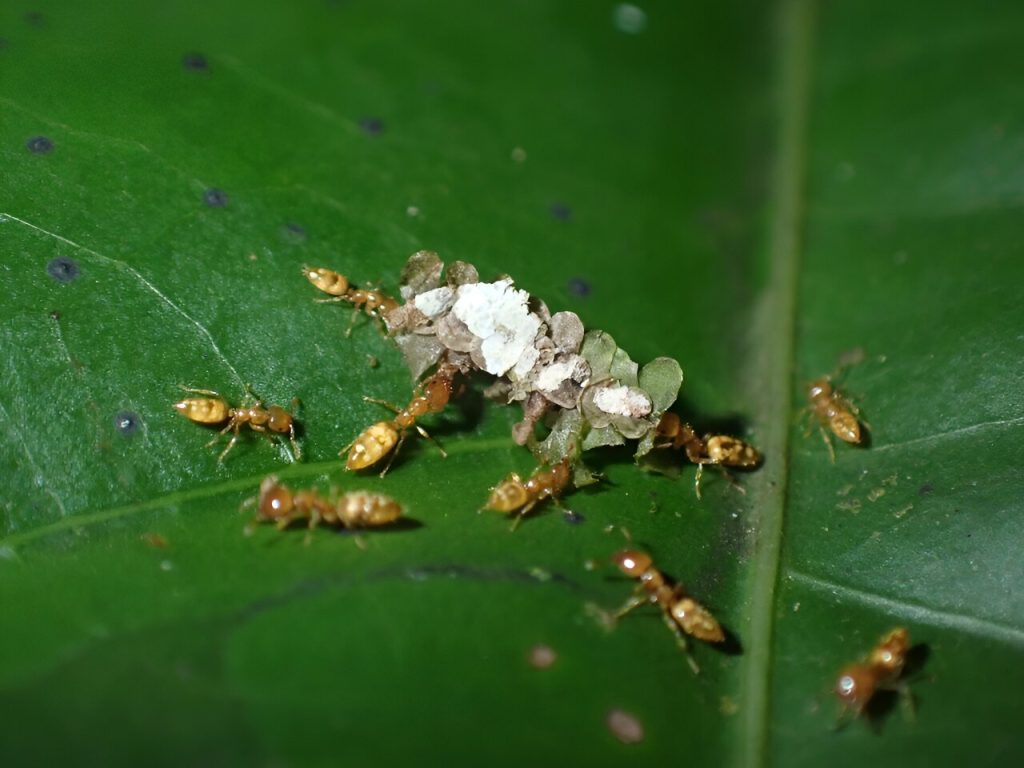Myrmelachista ants dig burrows into the trunks of living trees, protecting the understory leaves from debris and disease. Photo by Rodolfo Probst, University of Utah.
Ants are renowned for their ordered and complex social behavior and, in the tropics, for their symbiotic relationships with plants. Certain trees have prominent hollow bulges where the ants live and often provide them with food specifically for them. In return, the ants become combative bodyguards, launching aggressive swarms to protect the plant from predators. Scientists have been observing these symbiotic relationships for centuries, but the question of how these intriguing interactions evolved in the first place remains a perennial one.
That remains a mystery, but a new study led by field biologist Rodolfo Probst of the University of Utah is offering insights that could improve our understanding of the symbiotic relationship between ants and plants.
Published in Proceedings of the Royal Society BHis research focused on a genus of ants called Myrmelachista. Most Myrmelachista seed Ants build their nests in the dead or living stems of plants without any special symbiotic relationship. However, a group of species native to Central America is known to build their nests exclusively in the living stems of certain types of small shrubs in a special symbiotic relationship similar to other ant-plant symbiotic relationships. These small yellow ants hollow out the stems without harming the host plant and can be found throughout Central America.
Such symbiosis requires complex and novel behaviors and morphologies (Physical characteristics Symbiosis is thought to occur rarely, with species sharing a wide variety of characteristics, such as color, shape, size, etc. The Central American specialists were a population of nine species that shared these complex characteristics and differed only slightly from each other. It is thought that a single common ancestor must have evolved symbiosis over a long period of time, and these were very young species that appeared after symbiosis had evolved.
Probst made a startling discovery. Using DNA sequence data, Evolutionary historyIn his research, he found that these nine species appeared in two clusters on different parts of the evolutionary tree, meaning that this complex relationship, with all its characteristics, evolved twice from a non-specialized ancestor. Not only that, but they evolved very close together and at roughly the same time, about 3 million years ago.
“I’d love to jump in a time machine and see,” Probst said, “that maybe it’s the ecosystems and plants that allowed these friendships to develop in the first place.”

Biologist Rodolfo Probst leads University of Utah students on a field trip to Costa Rica. Photo courtesy of University of Utah
This is an example of convergent evolution, he argues, where different species evolve in similar directions, often because they occupy similar specialized ecological niches. Think whales and fish. Somehow, these ants developed the same behavior, which Probst calls “evolutionary déjà vu.”
“Because they are so similar, a simple assumption was made that this symbiotic relationship may have evolved once,” Probst said. “The most exciting thing about our paper is that it shows that this kind of ant-plant friendship has evolved many times independently. Is this evolutionary déjà vu? What happened once may happen again, given the right ecological conditions.”
The co-authors are renowned entomologist Jack Longino, better known among University of Utah students as the “Amazing Ant Man” for his expertise and the extensive personal collection of ant specimens kept on campus, and Michael Branstetter, a former postdoctoral researcher in the University of Utah’s Department of Biological Sciences now affiliated with the USDA’s Pollinator Insect Research Unit at Utah State University.
“The main story of this paper is the unexpected part: Rodolfo’s work uncovered two independent evolutions in complex relationships with plants. This suggests that the building blocks for the development of highly distinctive or complex traits are readily at hand and can evolve rapidly among different species when conditions are right,” said Longino, a university biology professor who has studied them for more than 40 years. AntsIt occurs mainly in tropical regions.
“Morphology alone was not enough to reveal the relationships between species, the evolutionary process of how life on Earth diversified.”
With ongoing support from the university’s Undergraduate Science Research Initiative, Probst plans to conduct whole-genome sequencing to uncover the genes involved in the ant-plant relationship and get an inside look at a phenomenon that has intrigued naturalists for centuries.
For more information:
Rodolfo S. Probst et al. “Evolutionary deja vu? A case of convergent evolution in ant-plant symbiosis” Proceedings of the Royal Society B: Biological Sciences (2024). DOI: 10.1098/rspb.2024.1214
Provided by
University of Utah
Quote: Ants and trees: “Evolutionary deja vu” in tropical rainforests (July 18, 2024) Retrieved July 19, 2024 from https://phys.org/news/2024-07-ants-trees-evolutionary-dj-vu.html
This document is subject to copyright. It may not be reproduced without written permission, except for fair dealing for the purposes of personal study or research. The content is provided for informational purposes only.


